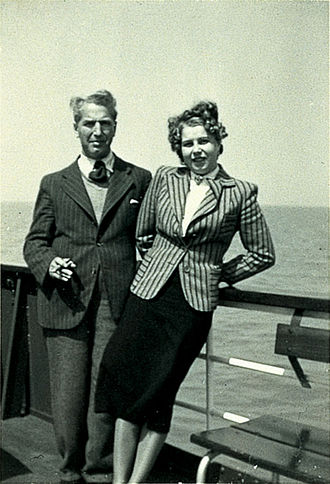Dr. Pfeffer and Kaletta met in 1936 when she visited him for dental work at his Berlin office. She was
van der Zee opined that she was "struck by the tragedy of a man [Pfeffer] in the shadow of a person well known like Anne Frank." Thereupon she embarked on a research project to learn what she could about the German dentist and authored her book, The Roommate of Anne Frank. In her own words, she wanted to know what kind of a person he was, "whether he hated, whether he loved, what [were] his weaknesses and his strengths." She wanted to understand the person who "like so many others, were exterminated as nobodies."
Friedrich "Fritz" Pfeffer was born in Giessen, Germany, in 1889 as one of five children. He trained as a dentist and jaw surgeon, and was certified to practice in 1911. During World War I, he served in the German army. After the war, he married Vera Bythiner, with whom he had a son, Werner. Vera and Dr. Pfeffer divorced in 1932 with Fritz being awarded custody of Werner. In 1938, the rising tide of anti-Semitism that swept across Germany persuaded the Jewish dentist to "send [Werner] into the care of his brother Ernst [also a dentist]" who had previously immigrated to England.
Pfeffer, called 'Dussel' by Anne [Frank] in her diary."
Besides the books and photos, Niesmeyer found a "pack of yellowed newspaper clippings" -- all of them about Anne Frank and her diary. Recognizing the significance of her find, she asked the flea market stallholder if he had any other of Kaletta's effects. A week later, the stallholder produced two photograph albums, a pack of loose snapshots, four 1939 letters from Dr. Pfeffer to Kaletta, and the last letter he wrote to her in November 1942, when he went into hiding with seven other Jews.
When the Dutch historian Nanda van der Zee read newspaper accounts about the find, she was intrigued: "Because neither the portrait, nor letter of Fritz Pfeffer matched in any way the image of "Dussel" as described by Anne."
Dussel was the pseudonym given Dr. Pfeffer by Anne in her diary -- she used pseudonyms in her diary for all the inhabitants of the attic. In German, Dussel means fool. van der Zee notes that Anne describes Dr. Pfeffer in her diary as "an unfriendly, petty-minded, and irritating man," concluding "that the way Anne had portrayed 'Dussel' needed to be rectified."
March 5, 2014 -- Anne Frank, the 13-year-old Jewish girl who was forced into hiding with her family in 1942 (while essentially a story of youthful optimism) lived and died in one of the saddest eras in all of history. Anne's diary memorialized the daily life of eight Jews confined like caged animals to a few rooms in second-story secret annex in a Dutch office building, which they inhabited for 25 terrifying months. Fate would be not kind to them. Just months before the war ended, a warehouseman betrayed them, and the Nazis deported them to concentration camps where all but one died, including Anne who would become the most famous victim of Adolf Hitler's Third Reich.
In October 1987, some 42 years after Anne's death, Joke Niesmeyer, an employee of Amsterdam's Anne Frank Foundation, found some of the household effects of Charlotte Kaletta at an Amsterdam flea market. The find consisted of a few books with Kaletta's name inscribed on the inside cover. Additionally, there was a small box of black and white photographs of a woman and an older man. As Niesmeyer looked at the pictures, she "suddenly saw a portrait of someone I recognized. It was [the dentist Dr. Fritz]
Page 1
By Daniel Demers, DrBicuspid.com contributing writer
Continued Page 2
Courtesy of:


2 portraits of Dr. Fritz Pfeffer, Anne Frank's roommate

Dr. Fritz Pfeffer and Charlotte Kaletta, 1939
Picture courtesy of
"the Ann Frank House"
E-MAIL ME ddemers901@sonic.net


